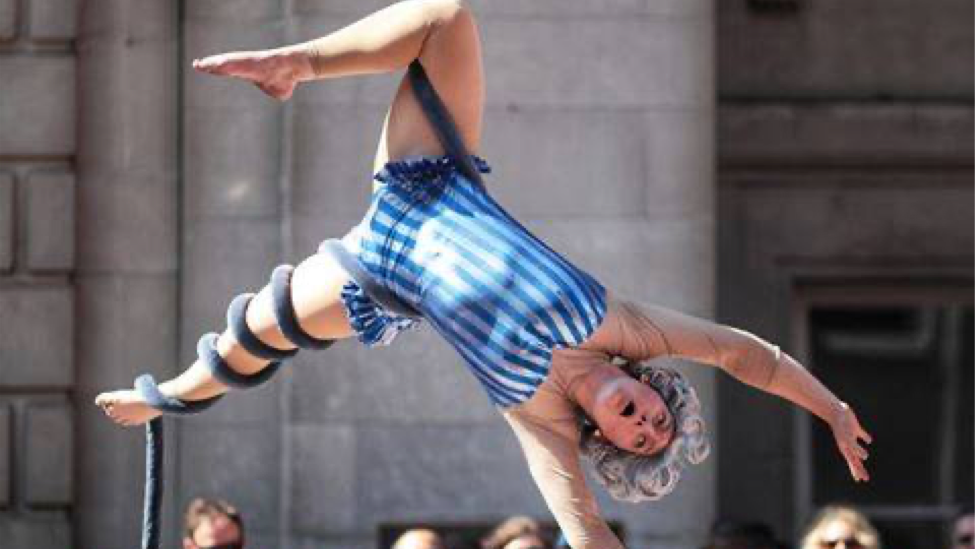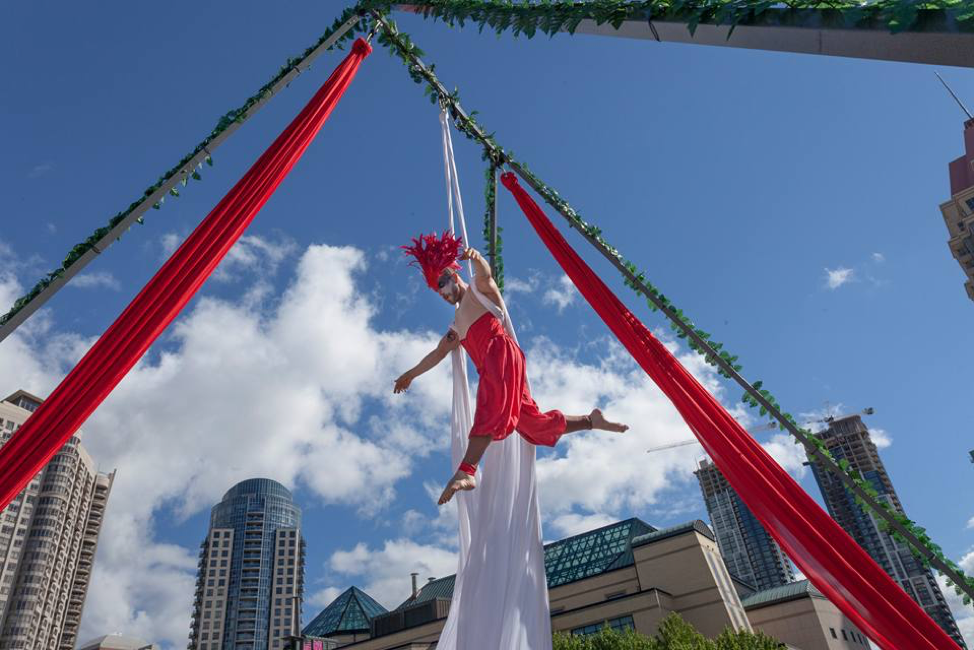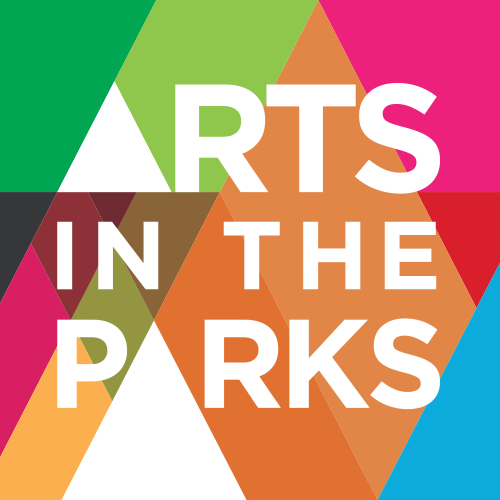
Blurring the Boundaries of Circus: Celebrating World Circus Day with Hercinia Arts Collective
Interview by The Arts in the Parks Team
“We’ve developed an inclusive definition of circus, as an art-form that encompasses any theatrical, performance-based work involving an element of spectacle and physical risk-taking.” – Emily Hughes, Co-Founder of Hercinia Arts Collective
The 17th of April marks 11 years of celebrating World Circus Day – a day created to celebrate and unite Circus arts and artists all over the world and to promote the incredible work they do to artists and individuals everywhere. Artists have been hit incredibly hard by the pandemic but amid the challenges brought on by COVID-19, artists all over the world have proved how resilient they really are.
From livestreaming performances online to socially distanced performances in public space, Hercinia Arts Collective has overcome many of the last minute hurdles in their path and have proved time and time again that nothing will stop them from creating an incredible show. Founded in 2009 by Natalie Parkinson and Emily Hughes, Hercinia Arts Collective has been “blurring the boundaries between traditional performance and visual art” for over 10 years. They’ve performed in street festivals, art events, showcases and in public space all over the country. As stated on their website: as circus, theatre and dance artists, their main investigation in performance is to use circus as a language through which to explore themes, characters or to tell stories.
“As a practice based on visuals and movement, circus is an exciting language because it can communicate on such a visceral level” (Hercinia Arts Collective)
This year, in celebration of World Circus Day we were so lucky to get the chance to talk to Emily Hughes and Zita Nyarady of Hercinia Arts Collective and talk about the amazing work they’ve done and how they’ve not only continued to create stunning and entertaining projects during a pandemic but also create a program that works to empower and encourage diverse narratives in Circus.

Arts in the Parks: Tell us about the history of Hercinia Arts Collective. How did the Collective come together?
Emily and Zita: Hercinia came into being in a coffee shop. Natalie and I had been working together with another company and, when that began to fall apart, we decided we wanted to keep collaborating and create our own thing. Essentially it began with a brainstorm session where we brought together some names, images and ideas and then just evolved from there. We knew we wanted to fuse our own art forms, myself an aerialist and actor, and Natalie an acrobat and dancer, and that we wanted to keep working with other people in other forms and stay open to possibilities. Over the course of the first few years, we just started bringing people in to collaborate on different projects and started to find others who were inspired to work in a similar way who would become key collaborators.
Arts in the Parks: Hercinia Arts has a signature style; your performances are entertaining, engaging and feature unique and amusing characters. What’s your process in creating these fun stories? How have you developed and honed this signature style over the years?
Emily and Zita: in the beginning when we were just starting out, our tactic was essentially to come up with an idea to pitch to any festival, art event or open application we could find. Then when something got selected, we would be like, ok, I guess we have to make this thing now. Then we would work together to make something, do it for the event, see what the audience reaction was and then keep adapting it from there. It’s essentially still how we work. Someone will come in with an idea and what gets realized will depend on scope and time and funding. Then we bring a team together to collectively make it a reality, and let it expand and evolve with everyone’s ideas, input and skills. And then we test it with an audience and learn from them. I think what really makes our signature style is those two points. Everything is done through collective creation, which influences the kind of work we make – and often results in sort of dance-y, acrobatic, silly characters – and then it keeps evolving with an audience, which is what makes it fun and engaging.

Arts in the Parks: Are there any misconceptions of Circus and Aerial Arts? What do you want people to know about your craft?
Emily and Zita: there are sort of two big misconceptions that we still run into. The first is that the vast majority of the general public still thinks that circus is either the kind of traditional circus you see in a big top tent, or that it’s Cirque du Soleil, and most people are not aware of the sort of evolving genre of Contemporary Circus as an art form, as opposed to just big spectacle entertainment. Even in terms of Arts Councils, The Canada Council for the Arts is the only funder that officially recognizes circus as an art form, which can be a huge barrier to creating innovative new work. And then within our own field there will be people who say, ‘oh, that’s not circus. It’s too weird” if it’s not big entertainment focused spectacle. So, then there’s this constant battle of where do we fit? We see Art and Entertainment as two ends of the same spectrum, and the kind of circus arts we do naturally hover somewhere within the middle and can cover a huge range of possibilities. For ourselves, we’ve developed an inclusive definition of circus, as an art-form that encompasses any theatrical, performance-based work involving an element of spectacle and physical risk-taking.
The second common misconception is around accessibility. The first reaction of many people who see a circus show is “Oh, I could never do that.” and it’s just not true! Like anything it’s about practice, and there are so many possibilities and disciplines within circus, that there is truly something for everyone. This is one of the reasons we’ve incorporated public workshops into our performances at Arts in the Parks, because we really want to encourage the idea that circus is for everyone.
Arts in the Parks: this year, Hercinia Arts Collective started an incredible Training Bursary Program specifically aimed at reducing inequities for Black, Indigenous and People of Colour who are pursuing a career in circus arts. Tell us about this program. What motivated you to start a project of this scale and why is it important that more programs like this exist?
Emily and Zita: it’s a program to help fund any training related expenses, including equipment, classes and space rentals, and it’s open to Ontario-based BIPOC Circus Artists at any stage of their career. They are small $100 bursaries, but applicants are welcome to apply multiple times, as we realize that circus training is ongoing.
The Training Bursary program first started because we were fortunate enough to get a bit of Emergency COVID funding from Canada Council for the Arts. And we really lucked out because we had never received project funding from CCA prior to 2019, and the way that they evaluated where that funding went was based on what organizations received funding that year. At the time we were mostly still trying to support our studio space, but it wasn’t enough to go very far towards our rent, and we felt very strongly that the money should go towards supporting artists. So we initially created it with the intent that it could help artists who were struggling financially continue to access training, which would in turn help studios and instructors that were offering what they could in terms of rentals and online classes. We found the response was amazing, and also that the majority of applicants were Black, Indigenous or other People of Colour – communities which are largely underrepresented in our industry. We were also looking to develop more policies around equity, inclusion and anti-racism, so it seemed like a natural fit to keep the program going however we could, but specifically target those who face the most inequities in accessing circus training. It’s actually such a small initiative. Because we don’t have any ongoing or operating funding, we are just putting a portion of any of our project budgets towards this fund. (If anyone wants to donate, you can on our website: www.herciniarts.com). But it’s important because, as a company that acts as an incubator for creating and producing works, we are always looking to encourage diverse voices, and the more we can foster inclusion at a base level just in access to training, the more diverse artists there will be. Ultimately though this feels like a Band-Aid solution – it’s definitely better than nothing – but real change is going to come from all studios enacting more antiracist policies, including prioritizing financial accessibility, even within the confines of the capitalist society that we live in (while we all keep working to hopefully, eventually dismantle it all together).

Arts in the Parks: this has been a challenging time for everyone, and our industry has been particularly hard-hit. How has your practice changed in the past year?
Emily and Zita: the biggest and most significant change would have to be that we permanently closed our studio. We’ve always relied on classes to support our rent and there just wasn’t enough government support in terms of policy or finance, and our landlord wasn’t willing to make any kind of reasonable accommodations, so in the summer we made the decision to shut down. Ultimately we didn’t have a choice because we absolutely would’ve been bankrupt by now otherwise, but it also ended up being one of the best decisions for a lot of other reasons. Existing without a studio space has allowed us to refocus our work into creation and invest in initiatives that support artists. It’s also meant that we have had the mental capacity to adapt and roll with all the ongoing changes that needed to happen to keep making art. Having access to CERB and CRB has been instrumental in this too, and has really made us realize how much a difference a basic income could make in the arts. Because we exist solely on funding from events and specific projects, so much of our day to day administration is unpaid work. Having a bit of financial security has meant that we actually have the capacity to invest more of our time in this work, which ultimately helps us to kick start more projects and support more artists.
As individuals we’ve had to figure out how to train and stay in shape. As circus artists so much of our practice is about ongoing physical training. There are some basic conditioning things that you can do from home, but aerial practice really requires specialized equipment and space, so what would normally be almost daily training has been really limited when it can happen at all. So we’ve also really had to adapt our expectations of what our bodies can do and look like, and embrace a bit more slowness in our day to day practices, which ultimately I think is a good thing.
In terms of our company work, we’ve been creative with rehearsals and meetings, using online platforms, rehearsing outdoors when possible, and masked indoors. Because we do work so collaboratively normally, this has definitely been a challenge, but has also allowed us to discover things that we might not have in person. We’ve been creative in the way we present work, thinking about how we can have safe, distanced, outdoor audiences, and how we can incorporate audience participation from a distance. We’ve even embraced some forms of digital dissemination, but always with the mindset that we are creating for a different medium and that it’s not the same as a live in-person performance.
There’s also just been a lot of waiting and unpredictability, so I would say in general our practice has become much more patient and adaptable.

Arts in the Parks: what additional projects do you have going on right now? Can you give us a sneak peak of what we can expect in 2021, despite this challenging time?
Emily and Zita: we actually have a lot of exciting things happening this summer, which are all of course, sort of pending conditions and restrictions.
We’re really excited to be part of Arts in the Parks again this year with our show HASA (Hercinia Arts Space Aerialists), which we’ll be presenting in Flagstaff Park in August. This will be our 4th year as part of Arts in the Parks, and we are so grateful for it. Doing small, community-based shows outdoors really feels like the perfect thing right now, so we are super thankful to all of the organizations (Toronto Arts Council, Toronto Arts Foundation, The City of Toronto & Park People) that make this program possible. We’ve also partnered with SoCirc (a local social circus organization) this year to offer a more in depth circus workshop for youth that will culminate in them performing vignettes as part of our professional show.
We’ve also got a new creation project coming up this summer, funded by Canada Council for the Arts. It’s just one part of a larger show The Chaos Project, conceived and directed by Kirsten Edwards. She’ll be working with choreographer Diana Lopez Soto and dramaturge Zita Nyarady to guide 7 aerialists in creation on an innovative new apparatus.
We’ve had to postpone for now with the latest round of restrictions, but we are really excited about PEEP, a new project conceived and curated by Madeleine Seignoret & Kirsten Edwards. It’s a modern take on a peep show where performances take place inside a large box while audiences peep in from outside through small windows. We’re planning on this being a hybrid in-person and digital event with super small audiences, and are hoping that we’ll be able to bring it to life in June.
We’ve also got a secret fun and light-hearted video project in the works that should be released soon. It was choreographed by Natalie Parkinson Dupley who then sent video of the choreography to the performers who each filmed themselves from home, so we’re excited to see how that comes together.
And finally we’re working on adapting our teaching practice to a digital space by creating some online asynchronous courses aimed at experienced aerialists. We’ve designed these to adapt to our current world, so these are all things that can either be done from home or with some limited access to studio space, and everything will be offered on a sliding scale to keep pricing accessible.
Though the future is uncertain and can seem a little scary right now – we’re so excited for the incredible circus performances from Hercinia Arts Collective!
Make sure you head on over to their website or Facebook page for more information about upcoming events and news and how you can support some of the incredible work Hercinia Arts Collective does. They also have awesome merch you can buy – go take a look!) Their upcoming show PEEP is currently underway, it will be a hybrid between online and live performances. For updates make sure to hop over to their Instagram to find all the links and info!

